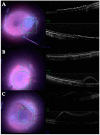Pars Plana Vitrectomy in Inherited Retinal Diseases: A Comprehensive Review of the Literature
- PMID: 37374028
- PMCID: PMC10305349
- DOI: 10.3390/life13061241
Pars Plana Vitrectomy in Inherited Retinal Diseases: A Comprehensive Review of the Literature
Abstract
Inherited retinal diseases (IRDs) are a group of clinically and genetically heterogeneous disorders that may be complicated by several vitreoretinal conditions requiring a surgical approach. Pars plana vitrectomy (PPV) stands as a valuable treatment option in these cases, but its application in eyes with such severely impaired chorioretinal architectures remains controversial. Furthermore, the spreading of gene therapy and the increasing use of retinal prostheses will end up in a marked increase in demand for PPV surgery for IRD patients. The retinal degeneration that typically affects patients with hereditary retinal disorders may influence the execution of the surgery and the expected results. Considering the importance of PPV application in IRD-related complications, it is fundamental to try to understand from the literature what is adequate and safe in posterior eye segment surgery. Use of dyes, light toxicity, and risk of wounding scar development have always been themes that discourage the execution of vitreoretinal surgery in already impaired eyes. Therefore, this review aims to comprehensively summarize all PPV applications in different IRDs, highlighting the favorable results as well as the potential precautions to consider when performing vitreoretinal surgery in these eyes.
Keywords: Stargardt disease; X-linked retinoschisis; best disease; choroideremia; familiar exudative vitreoretinopathy; pars plana vitrectomy; retinitis pigmentosa.
Conflict of interest statement
The authors declare no conflict of interest.
Figures


References
Publication types
LinkOut - more resources
Full Text Sources
Miscellaneous

